PFLOTRAN-SIP: A PFLOTRAN Module for Simulating Spectral-Induced Polarization of Electrical Impedance Data
Abstract
1. Introduction
2. PFLOTRAN-SIP: Process Models and Coupling Framework
2.1. E4D Process Model
2.2. PFLOTRAN Process Models
2.3. PFLOTRAN-SIP Coupling
| Algorithm 1 Overview of the proposed PFLOTRAN-SIP framework for simulating electrical impedance data. |
|
2.4. Petrophysical Transformation
2.5. Mesh Interpolation
3. Methodology
3.1. PFLOTRAN Model Setup
3.2. SIP Model Setup
3.3. SIP Inversion of Electrical Conductivity
4. Results & Discussion
Limitations and Challenges
5. Conclusions
Author Contributions
Funding
Conflicts of Interest
Computer Code Availability, Installation, and Contribution
References
- Council, N.R. Research Needs in Subsurface Science; National Academies Press: Washington, DC, USA, 2000. [Google Scholar]
- Revil, A.; Finizola, A.; Ricci, T.; Delcher, E.; Peltier, A.; Cabusson, S.B.; Avard, G.; Bailly, T.; Bennati, L.; Byrdina, S.; et al. Hydrogeology of Stromboli volcano, Aeolian Islands (Italy) from the interpretation of resistivity tomograms, self-potential, soil temperature and soil CO2 concentration measurements. Geophys. J. Int. 2011, 186, 1078–1094. [Google Scholar] [CrossRef]
- Kearey, P.; Brooks, M.; Hill, I. An Introduction to Geophysical Exploration; John Wiley & Sons: Boston, MA, USA, 2013. [Google Scholar]
- Snieder, R.; Hubbard, S.; Haney, M.; Bawden, G.; Hatchell, P.; Revil, A.; DOE Geophysical Monitoring Working Group. Advanced noninvasive geophysical monitoring techniques. Ann. Rev. Earth Plan. Sci. 2007, 35, 653–683. [Google Scholar] [CrossRef]
- Carpenter, C. Stress dependence of sandstone electrical properties and deviations from Archie’s law. J. Petr. Tech. 2017, 69, 51–58. [Google Scholar]
- Kaselow, A.; Shapiro, S.A. Stress sensitivity of elastic moduli and electrical resistivity in porous rocks. J. Geophys. Eng. 2004, 1, 1–11. [Google Scholar] [CrossRef]
- Gresse, M.; Vandemeulebrouck, J.; Byrdina, S.; Chiodini, G.; Revil, A.; Johnson, T.C.; Ricci, T.; Vilardo, G.; Mangiacapra, A.; Lebourg, T.; et al. Three-dimensional electrical resistivity tomography of the Solfatara Crater (Italy): Implication for the multiphase flow structure of the shallow hydrothermal system. J. Geophys. Res. 2017, 122, 8749–8768. [Google Scholar] [CrossRef]
- Robinson, J.; Johnson, T.C.; Slater, L. Challenges and opportunities for fractured rock imaging using 3D cross-borehole electrical resistivity. Geophysics 2015, 80, E49–E61. [Google Scholar] [CrossRef]
- Byrdina, S.; Rucker, C.; Zimmer, M.; Friedel, S.; Serfling, U. Self-potential signals preceding variations of fumarole activity at Merapi volcano, Central Java. J. Volcanol. Geotherm. Res. 2012, 215–216, 40–47. [Google Scholar] [CrossRef]
- Revil, A.; Finizola, A.; Sortino, F.; Ripepe, M. Geophysical investigations at Stromboli volcano, Italy: Implications for ground water flow and paroxysmal activity. Geophys. J. Int. 2004, 157, 426–440. [Google Scholar] [CrossRef]
- Yan, L.; Xiang, K.; Li, P.; Liu, X.; Wang, Z. Study on the induced polarization model in the exploration for shale gas in southern China. In SEG Technical Program Expanded Abstracts; Society of Exploration Geophysicist: Tulsa, OK, USA, 2014; pp. 912–916. [Google Scholar]
- He, Z.; Jiang, W.O.; Liu, P.; Cui, X. Hydrocarbon detection with high-power spectral induced polarization, two cases. In Proceedings of the 67th EAGE Conference & Exhibition, Madrid, Spain, 13–16 June 2005. [Google Scholar]
- Sumner, J.S. Principles of Induced Polarization for Geophysical Exploration; Elsevier: Amsterdam, The Netherlands, 1976; Volume 5. [Google Scholar]
- Vaudelet, P.; Revil, A.; Schmutz, M.; Franceschi, M.; Bègassat, P. Induced polarization signatures of cations exhibiting differential sorption behaviors in saturated sands. Water Resour. Res. 2011, 47. [Google Scholar] [CrossRef]
- Luo, Y.; Zhang, G. Theory and Application of Spectral Induced Polarization; Number 8 in Geophysical Monogram Series; SEG: Tulsa, OK, USA, 1998. [Google Scholar]
- Olhoeft, G.R. Direct detection of hydrocarbon and organic chemicals with ground penetrating radar and complex resistivity. In Proceedings of the National Water Well Association, American Petroleum Institute, Petroleum Hydrocarbons and Organic Chemicals in Ground Water-Prevention, Detection and Restoration, Dublin, Ireland, 12–16 November 1986. [Google Scholar]
- Morgan, F.D.; Scira-Scappuzzo, F.; Shi, W.; Rodi, W.; Sogade, J.; Vichabian, Y.; Lesmes, D.P. Induced polarization imaging of a jet fuel plume. In Proceedings of the Symposium on the Application of Geophysics to Engineering and Environmental Problems, Oakland, CA, USA, 14 March 1999; pp. 541–548. [Google Scholar]
- Vanhala, H. Mapping oil-contaminated sand and till with the spectral induced polarization (SIP) method. Geophys. Prospect. 1997, 45, 303–326. [Google Scholar] [CrossRef]
- Aristodemou, E.; Thomas-Betts, A. DC resistivity and induced polarisation investigations at a waste disposal site and its environments. J. Appl. Geophys. 2000, 44, 275–302. [Google Scholar] [CrossRef]
- Butler, D.K. Near Surface Geophysics; SEG: Tulsa, OK, USA, 2005. [Google Scholar]
- Masi, M.; Ferdos, F.; Losito, G.; Solari, L. Monitoring of internal erosion processes by time-lapse electrical resistivity tomography. J. Hydrol. 2020, 589, 125340. [Google Scholar] [CrossRef]
- Zhao, K.; Xu, Q.; Liu, F.; Xiu, D.; Ren, X. Field monitoring of preferential infiltration in loess using time-lapse electrical resistivity tomography. J. Hydrol. 2020, 591, 125278. [Google Scholar] [CrossRef]
- Lantini, L.; Tosti, F.; Ciampoli, L.; Alani, A. A frequency spectrum-based processing framework for the assessment of tree root systems. In SPIE Future Sensing Technologies; International Society for Optics and Photonics: Bellingham, WA, USA, 2020; Volume 11525, p. 115251J. [Google Scholar]
- Maierhofer, T.; Katona, T.; Hilbich, C.; Hauck, C.; Flores-Orozco, A. Prospecting alpine permafrost with Spectral Induced Polarization in different geomorphological landforms. In Proceedings of the 22nd EGU General Assembly, Online, 4–8 May 2020; p. 10131. [Google Scholar]
- Palacios, A.; Ledo, J.J.; Linde, N.; Luquot, L.; Bellmunt, F.; Folch, A.; Marcuello, A.; Queralt, P.; Pezard, P.A.; Martínez, L.; et al. Time-lapse cross-hole electrical resistivity tomography (CHERT) for monitoring seawater intrusion dynamics in a Mediterranean aquifer. Hydrol. Earth Syst. Sci. 2020, 24, 2121–2139. [Google Scholar] [CrossRef]
- Kenma, A.; Vandenborght, J.; Kulessa, B.; Vereecken, H. Imaging and characterisation of subsurface solute transport using electrical resistivity tomography (ERT) and equivalent transport models. J. Hydrol. 2002, 267, 125–146. [Google Scholar]
- Atekwana, E.A.; Slater, L.D. Biogeophysics: A new frontier in Earth science research. Rev. Geophys. 2009, 47. [Google Scholar] [CrossRef]
- Mellage, A.; Smeaton, C.M.; Furman, A.; Atekwana, E.A.; Rezanezhad, F.; Van Cappellen, P. Linking spectral induced polarization (SIP) and subsurface microbial processes: Results from sand column incubation experiments. Environ. Sci. Technol. 2018, 52, 2081–2090. [Google Scholar] [CrossRef] [PubMed]
- Slater, L.; Binley, A.; Versteeg, R.; Cassiani, G.; Birken, R.; Sandberg, S. A 3D ERT study of solute transport in a large experimental tank. J. Appl. Geophys. 2002, 49, 211–229. [Google Scholar] [CrossRef]
- Madsen, L.; Fiandaca, G.; Auken, E. 3-D time-domain spectral inversion of resistivity and full-decay induced polarization data—Full solution of Poisson’s equation and modelling of the current waveform. Geophys. J. Int. 2020, 223, 2101–2116. [Google Scholar] [CrossRef]
- Loke, M.H.; Barker, R.D. Rapid least-squares inversion of apparent resistivity pseudosections by a quasi-Newton method. Geophys. Prospect. 1996, 44, 131–152. [Google Scholar] [CrossRef]
- Loke, M.H.; Acworth, I.; Dahlin, T. A comparison of smooth and blocky inversion methods in 2D electrical imaging surveys. Explor. Geophys. 2003, 34, 182–187. [Google Scholar] [CrossRef]
- Loke, M.H. RES3DINV Ver. 3.15 Rapid 3D Resistivity & I. P. Inversion Using the Least-Square Method; Geotomo Software: Saint Petersburg, Russia, 2019. [Google Scholar]
- Fiandaca, G.; Ramm, J.; Binley, A.; Christiansen, A.V.; Auken, E. Spectral information through 2D inversion of time domain induced polarization. In Proceedings of the Symposium on the Application of Geophysics to Engineering and Environmental Problems, Denvar, CO, USA, 17–21 March 2013; p. 808. [Google Scholar]
- Rücker, C.; Günther, T.; Spitzer, K. Three-dimensional modelling and inversion of DC resistivity data incorporating topography—I. Modelling. Geophys. J. Int. 2006, 166, 495–505. [Google Scholar] [CrossRef]
- Günther, T.; Rücker, C.; Spitzer, K. Three-dimensional modelling and inversion of DC resistivity data incorporating topography—II. Inversion. Geophys. J. Int. 2006, 166, 506–517. [Google Scholar] [CrossRef]
- Resistivity Inversion Software Manual; American Geosciences Institute: Austin, TX, USA, 2008.
- Johnson, T.C.; Versteeg, R.J.; Ward, A.; Day-Lewis, F.D.; Revil, A. Improved hydrogeophysical characterization and monitoring through parallel modeling and inversion of time-domain resistivity and induced-polarization data. Geophysics 2010, 75, WA27–WA41. [Google Scholar] [CrossRef]
- Rucker, C.; Gunther, T.G.; Wagner, F.M. pyGIMLi: An open-source library for modelling and inversion in geophysics. Comput. Geosci. 2017, 109, 106–123. [Google Scholar] [CrossRef]
- ZONDRES3D. Software for Three-Dimensional Interpretation of Data Obtained by Resistivity and Induced Polarization Methods (Land, Borehole, and Marine Variants); Zond Geop. Soft.: Saint Petersburg, Russia, 2017. [Google Scholar]
- Johnson, T.C.; Hammond, G.E.; Chen, X. PFLOTRAN-E4D: A parallel open-source PFLOTRAN module for simulating time-lapse electrical resistivity data. Comput. Geosci. 2017, 99, 72–80. [Google Scholar] [CrossRef]
- Hammond, G.E.; Lichtner, P.C.; Mills, R.T. Evaluating the performance of parallel subsurface simulators: An illustrative example with PFLOTRAN. Water Resour. Res. 2014, 50, 208–228. [Google Scholar] [CrossRef] [PubMed]
- Hammond, G.E.; Lichtner, P.C.; Lu, C.; Mills, R.T. PFLOTRAN: Reactive flow & transport code for use on laptops to leadership-class supercomputers. In Groundwater Reactive Transport Models; Bentham Science Publishers: Sharjah, UAE, 2012; pp. 141–159. [Google Scholar]
- Lichtner, P.C.; Hammond, G.E.; Lu, C.; Karra, S.; Bisht, G.; Andre, B.; Mills, R.T.; Kumar, J.; Frederick, J.M. PFLOTRAN Web Page. 2019. Available online: http://www.pflotran.org (accessed on 1 December 2020).
- Lichtner, P.C.; Hammond, G.E.; Lu, C.; Karra, S.; Bisht, G.; Andre, B.; Mills, R.T.; Kumar, J.; Frederick, J.M.; PFLOTRAN User Manual. Technical Report. 2019. Available online: http://documentation.pflotran.org (accessed on 1 December 2020).
- PNNL. E4D. 2014. Available online: https://e4d.pnnl.gov/Pages/Home.aspx (accessed on 1 December 2020).
- Johnson, T.C. E4D: A Distributed Memory Parallel Electrical Geophysical Modeling and Inversion Code; Pacific Northwest National Laboratory: Richland, WA, USA, 2014. [Google Scholar]
- Archie, G.E. The electrical resistivity log as an aid in determining some reservoir characteristics. Trans. AIME 1942, 146, 54–62. [Google Scholar] [CrossRef]
- Cole, K.S.; Cole, R.H. Dispersion and absorption in dielectrics I. Alternating current characteristics. J. Chem. Phys. 1941, 9, 341–351. [Google Scholar] [CrossRef]
- Tarasov, A.; Titov, K. On the use of the Cole–Cole equations in spectral induced polarization. Geophys. J. Int. 2013, 195, 352–356. [Google Scholar] [CrossRef]
- Johnson, T.C.; Thomle, J. 3D decoupled inversion of complex conductivity data in the real number domain. Geophys. J. Int. 2017, 212, 284–296. [Google Scholar] [CrossRef]
- Lipnikov, K.; Manzini, G.; Shashkov, M. Mimetic finite difference method. JCP 2014, 257, 1163–1227. [Google Scholar] [CrossRef]
- Droniou, J. Finite volume schemes for diffusion equations: Introduction to and review of modern methods. Matical Model. Methods Appl. Sci. 2014, 24, 1575–1619. [Google Scholar] [CrossRef]
- Seigel, H.O. Mathematical formulation and type curves for induced polarization. Geophysics 1959, 24, 547–565. [Google Scholar] [CrossRef]
- Oldenburg, D.W.; Li, Y. Inversion of induced polarization data. Geophysics 1994, 59, 1327–1341. [Google Scholar] [CrossRef]
- Hughes, T.J.R. The Finite Element Method: Linear Static and Dynamic Finite Element Analysis; Prentice-Hall: Upper Saddle River, NJ, USA, 2012. [Google Scholar]
- Si, H. TetGen, a Delaunay-based quality tetrahedral mesh generator. ACM Trans. Math. Softw. 2015, 41, 11. [Google Scholar] [CrossRef]
- Lichtner, P.C.; Hammond, G.E.; Lu, C.; Karra, S.; Bisht, G.; Andre, B.; Mills, R.; Kumar, J. PFLOTRAN User Manual: A Massively Parallel Reactive Flow and Transport Model for Describing Surface and Subsurface Processes; Los Alamos National Laboratory: Los Alamos, NM, USA, 2015. [Google Scholar] [CrossRef]
- Balay, S.; Abhyankar, S.; Adams, M.; Brown, J.; Brune, P.; Buschelman, K.; Dalcin, L.D.; Eijkhout, V.; Gropp, W.; Kaushik, D. PETSc Users Manual Revision 3.8; Technical Report; ANL: Chicago, IL, USA, 2017. [Google Scholar]
- Glover, P.W.J. A generalized Archie’s law for n-phases. Geophysics 2010, 75, E247–E265. [Google Scholar] [CrossRef]
- Shah, P.H.; Singh, D.N. Generalized Archie’s law for estimation of soil electrical conductivity. J. ASTM Int. 2005, 2, 1–20. [Google Scholar]
- Cole, K.S.; Cole, R.H. Dispersion and absorption in dielectrics II. Direct current characteristics. J. Chem. Phy. 1942, 10, 98–105. [Google Scholar] [CrossRef]
- Dias, C.A. Developments in a model to describe low-frequency electrical polarization of rocks. Geophysics 2000, 65, 437–451. [Google Scholar] [CrossRef]
- Revil, A.; Florsch, N.; Camerlynck, C. Spectral induced polarization porosimetry. Geophys. J. Int. 2014, 198, 1016–1033. [Google Scholar] [CrossRef]
- Titov, K.; Komarov, V.; Tarasov, V.; Levitski, A. Theoretical and experimental study of time domain-induced polarization in water-saturated sands. J. Appl. Geophys. 2002, 50, 417–433. [Google Scholar] [CrossRef]
- Scales, J.A.; Gersztenkorn, A. Robust methods in inverse theory. Inverse Probl. 1988, 4, 1071. [Google Scholar] [CrossRef]
- Jones, D.; Paul, A. Acid leaching behavior of sulfide and oxide minerals determined by electrochemical polarization measurements. Miner. Eng. 1995, 8, 511–521. [Google Scholar] [CrossRef]
- Alvarez, R. Complex dielectric permittivity in rocks: A method for its measurement and analysis. Geophysics 1973, 38, 920–940. [Google Scholar] [CrossRef]
- Chelidze, T.L.; Gueguen, Y. Electrical spectroscopy of porous rocks: A review—I. Theoretical models. Geophys. J. Int. 1999, 137, 1–15. [Google Scholar] [CrossRef]
- Lesmes, D.P.; Morgan, F.D. Dielectric spectroscopy of sedimentary rocks. J. Geophys. Res. 2001, 106, 13329–13346. [Google Scholar] [CrossRef]
- Chen, Y.; Or, D. Geometrical factors and interfacial processes affecting complex dielectric permittivity of partially saturated porous media. Water Resour. Res. 2006, 42. [Google Scholar] [CrossRef]
- De Lima, O.A.L.; Sharma, M.M. A generalized Maxwell-Wagner theory for membrane polarization in shaly sands. Geophysics 1992, 57, 431–440. [Google Scholar] [CrossRef]
- Leroy, P.; Revil, A. A mechanistic model for the spectral induced polarization of clay materials. J. Geophys. Res. 2009, 114. [Google Scholar] [CrossRef]
- Revil, A. Spectral induced polarization of shaly sands: Influence of the electrical double layer. Water Resour. Res. 2012, 48. [Google Scholar] [CrossRef]
- Dukhin, S.S.; Shilov, V.N.; Bikerman, J.J. Dielectric phenomena and double layer in disperse systems and polyelectrolytes. J. Electrochem. Soc. 1974, 121, 154C. [Google Scholar] [CrossRef]
- Marshall, D.J.; Madden, T.R. Induced polarization, a study of its causes. Geophysics 1959, 24, 790–816. [Google Scholar] [CrossRef]
- Vinegar, H.J.; Waxman, M.H. Induced polarization of shaly sands. Geophysics 1984, 49, 1267–1287. [Google Scholar] [CrossRef]
- Wong, J. An electrochemical model of the induced-polarization phenomenon in disseminated sulfide ores. Geophysics 1979, 44, 1245–1265. [Google Scholar] [CrossRef]
- Merriam, J.B. Induced polarization and surface electrochemistry. Geophysics 2007, 72, F157–F166. [Google Scholar] [CrossRef]
- Seigel, H.; Nabighian, M.; Parasnis, D.S.; Vozoff, K. The early history of the induced polarization method. Lead. Edge 2007, 26, 312–321. [Google Scholar] [CrossRef]
- Revil, A.; Florsch, N. Determination of permeability from spectral induced polarization in granular media. Geophys. J. Int. 2010, 181, 1480–1498. [Google Scholar] [CrossRef]
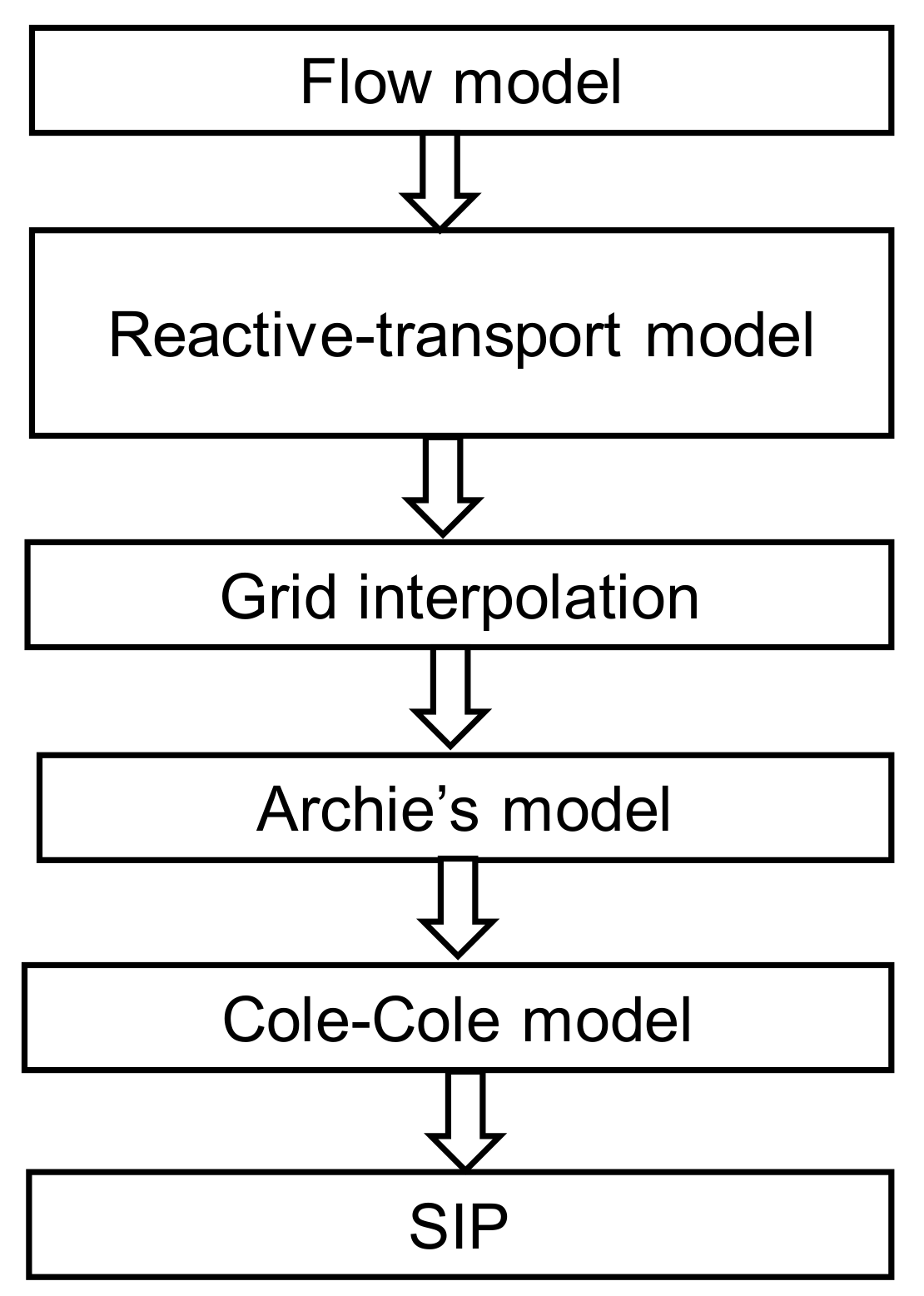
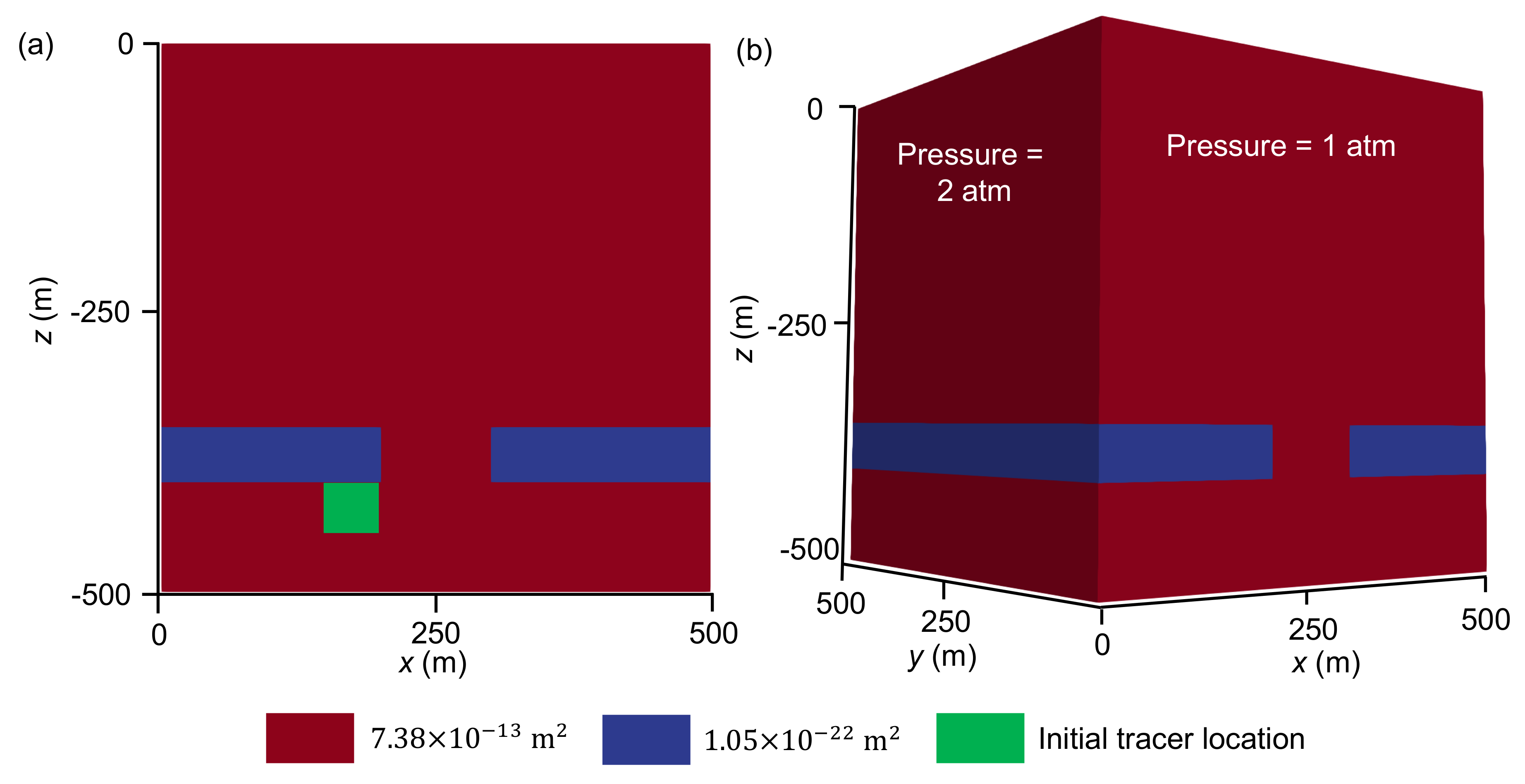
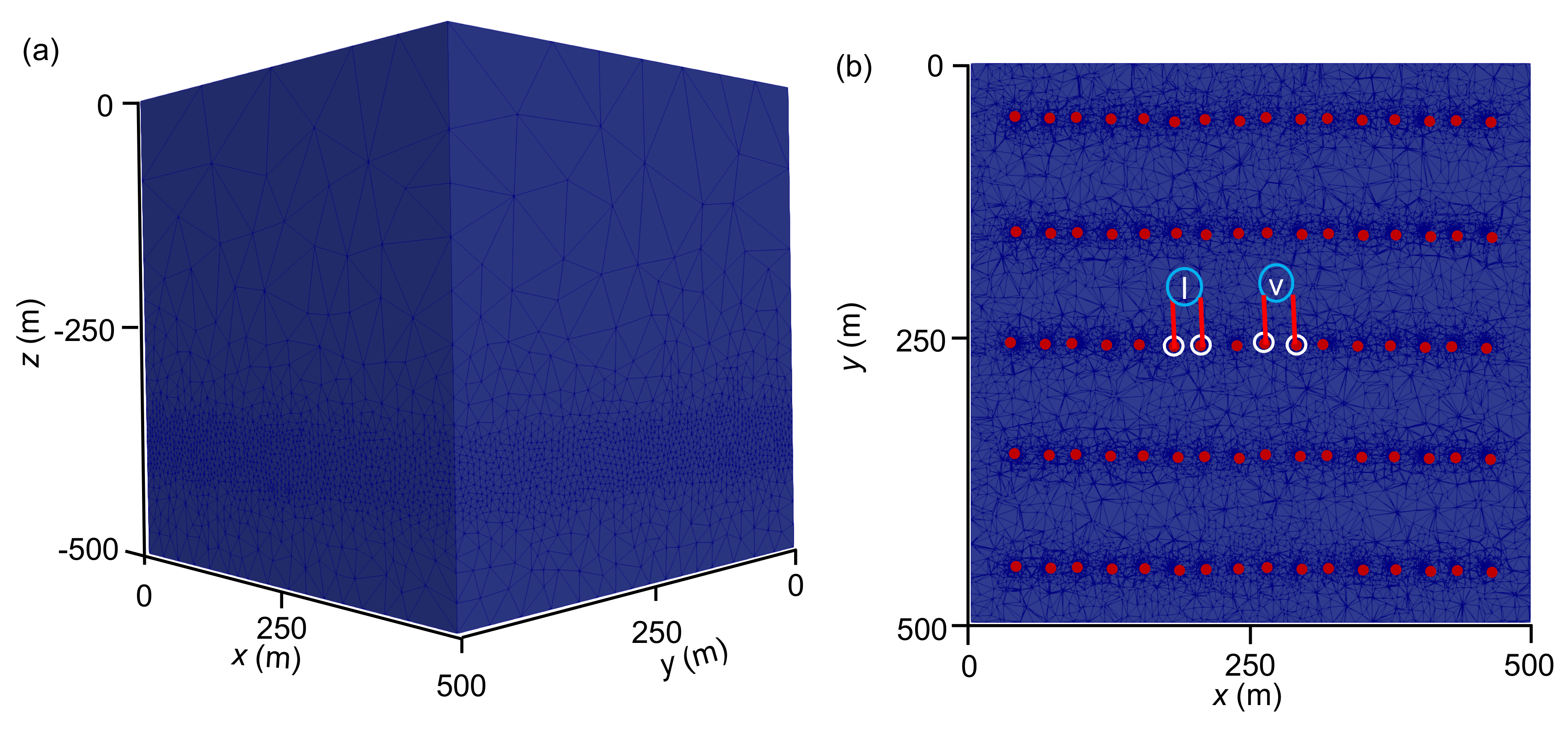
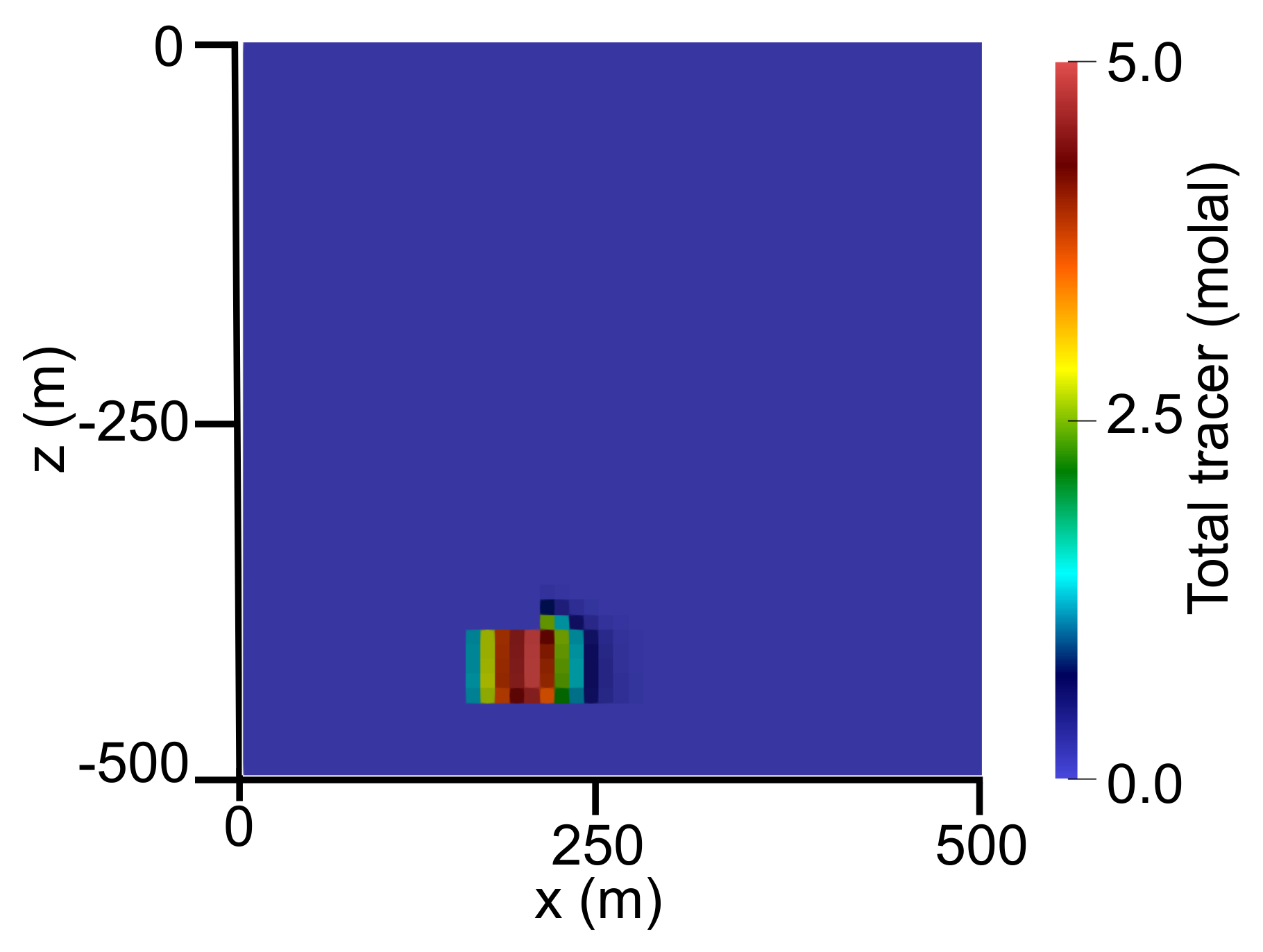
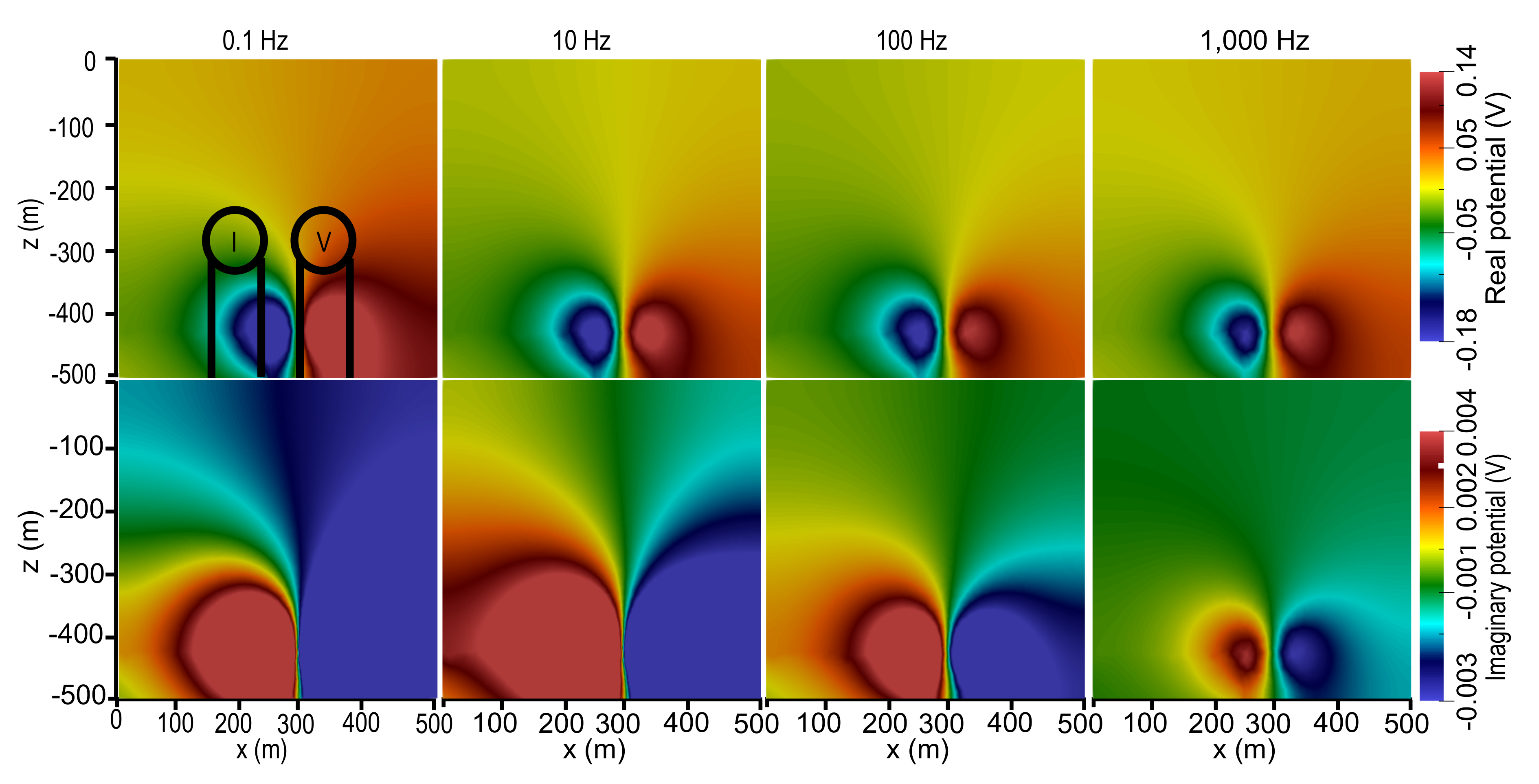
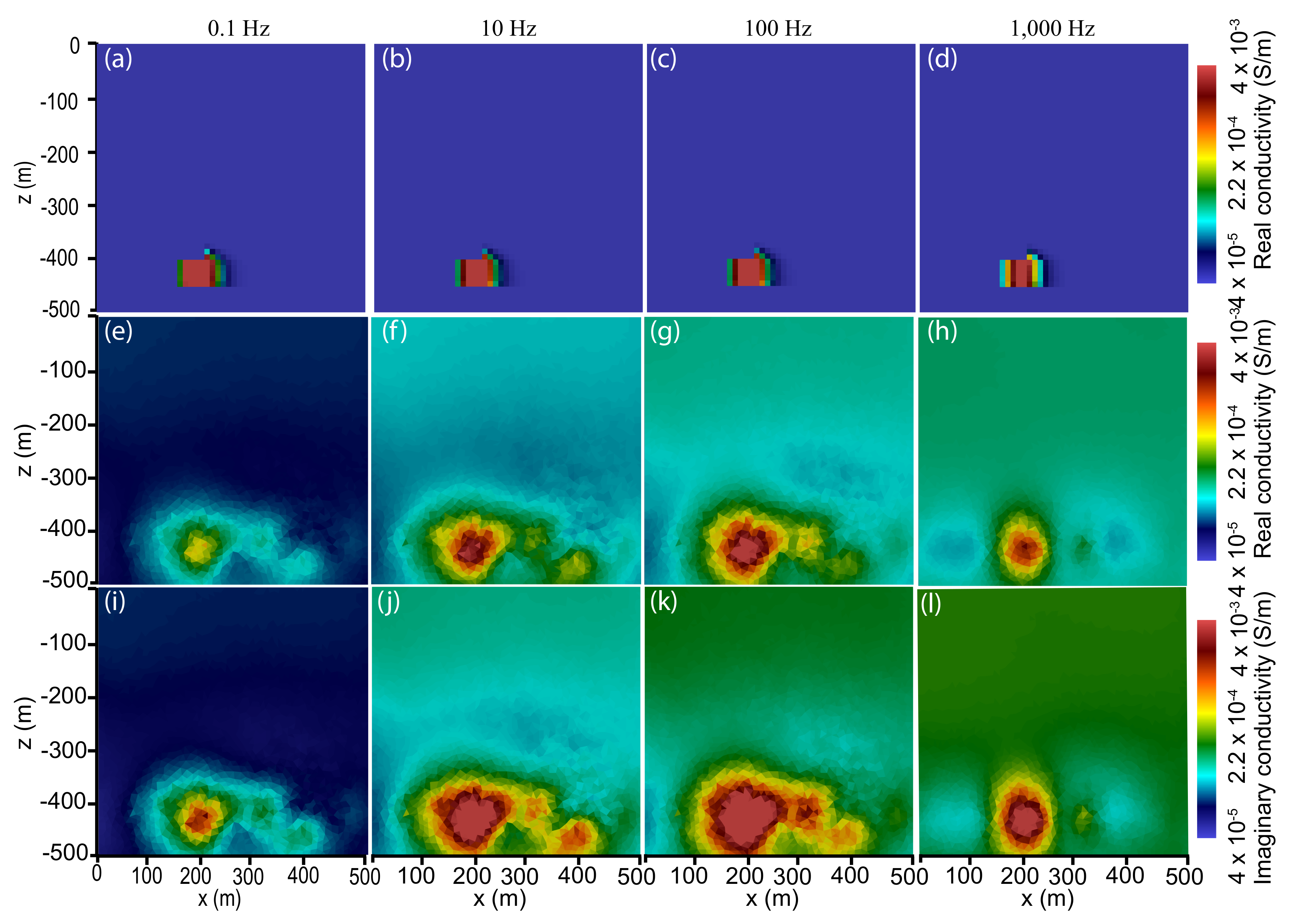
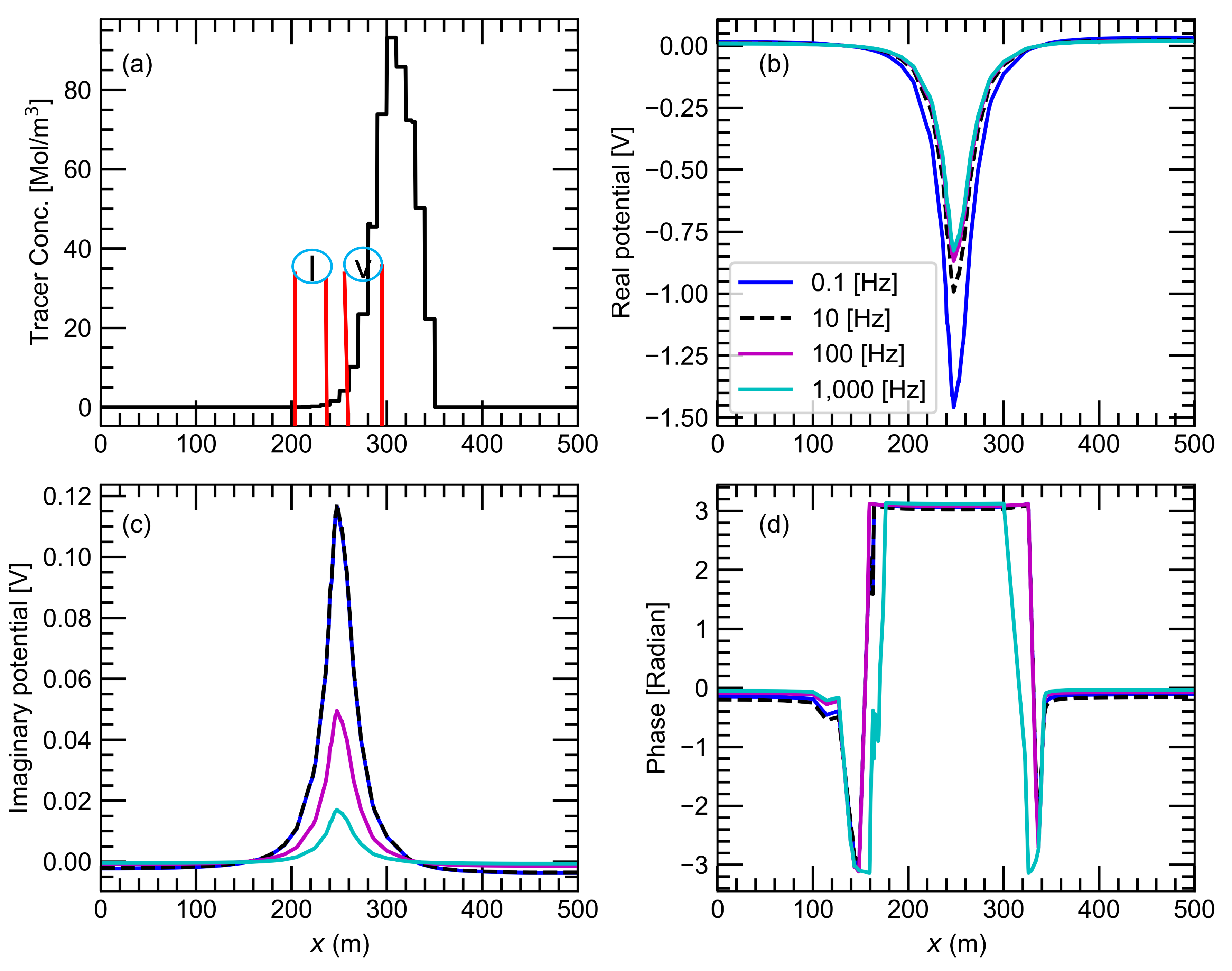
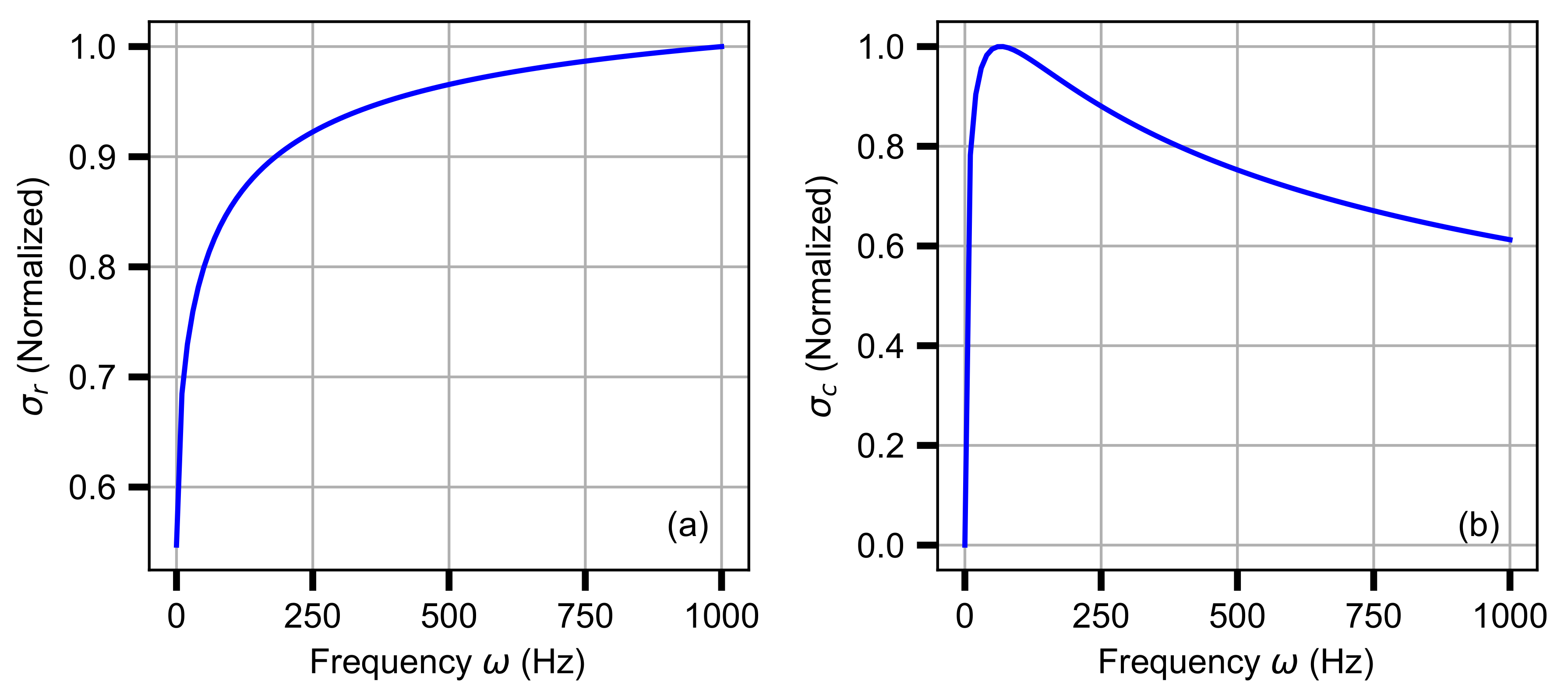
| PFLOTRANParameters | Values | SIPParameters | Values |
|---|---|---|---|
| (top & bottom layers) | Injected current | 1 | |
| (middle layer) | heterogeneous values Sm | ||
| Initial solute concentration | 10 | 0.564 | |
| (top and bottom layers) | 0.3% | 0.576 | |
| (middle layer) | 0.25% | 0.061 | |
| Diffusivity | 10 | 0.1, 1, 10, 100, and 1000 Hz |
Publisher’s Note: MDPI stays neutral with regard to jurisdictional claims in published maps and institutional affiliations. |
© 2020 by the authors. Licensee MDPI, Basel, Switzerland. This article is an open access article distributed under the terms and conditions of the Creative Commons Attribution (CC BY) license (http://creativecommons.org/licenses/by/4.0/).
Share and Cite
Ahmmed, B.; Mudunuru, M.K.; Karra, S.; James, S.C.; Viswanathan, H.; Dunbar, J.A. PFLOTRAN-SIP: A PFLOTRAN Module for Simulating Spectral-Induced Polarization of Electrical Impedance Data. Energies 2020, 13, 6552. https://doi.org/10.3390/en13246552
Ahmmed B, Mudunuru MK, Karra S, James SC, Viswanathan H, Dunbar JA. PFLOTRAN-SIP: A PFLOTRAN Module for Simulating Spectral-Induced Polarization of Electrical Impedance Data. Energies. 2020; 13(24):6552. https://doi.org/10.3390/en13246552
Chicago/Turabian StyleAhmmed, Bulbul, Maruti Kumar Mudunuru, Satish Karra, Scott C. James, Hari Viswanathan, and John A. Dunbar. 2020. "PFLOTRAN-SIP: A PFLOTRAN Module for Simulating Spectral-Induced Polarization of Electrical Impedance Data" Energies 13, no. 24: 6552. https://doi.org/10.3390/en13246552
APA StyleAhmmed, B., Mudunuru, M. K., Karra, S., James, S. C., Viswanathan, H., & Dunbar, J. A. (2020). PFLOTRAN-SIP: A PFLOTRAN Module for Simulating Spectral-Induced Polarization of Electrical Impedance Data. Energies, 13(24), 6552. https://doi.org/10.3390/en13246552






